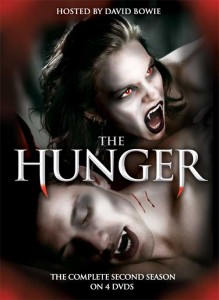The freaks are out there. They look like everyday people, masquerading as the homeless, the crazies, the street people.
They lurk on the street corners, warm themselves around garbage can fires, and watch for certain people, the ones with the brightest inner fires. They hunt them, suck the life from them, kill them horribly. The freaks are out there, and if you’re not watching carefully, you’ll miss the odd way they look at you, and the way their skin stretches unnaturally…
Nicky Straw (played by James Marshall, best known for his role as biker James Hurley on the show Twin Peaks) is one of the very few people unfortunate enough to know the freaks exist. They killed his wife. They killed his child. They’re after him.
Only by killing them first can he survive, but the struggle has taken a terrible toll on his life and sanity.
 Luann Somerson (Kim Huffman) is an old friend of Nicky’s from college, who finds him on the street and takes him in to her apartment, building upon happier memories of younger days. She’s just come out of a relationship, and in her loneliness, she finds the need for company. But it blinds her to the unsettlingly manner in which Nicky watches the people around him. Soon, though, it becomes clear that Nicky has a dangerous secret, living in a world of kill or be killed. Street people are being stabbed to death. Is he a potential victim, or is he the killer? And what happens when Luann’s comfortable world is shattered by the knowledge that the freaks are, indeed, real?
Luann Somerson (Kim Huffman) is an old friend of Nicky’s from college, who finds him on the street and takes him in to her apartment, building upon happier memories of younger days. She’s just come out of a relationship, and in her loneliness, she finds the need for company. But it blinds her to the unsettlingly manner in which Nicky watches the people around him. Soon, though, it becomes clear that Nicky has a dangerous secret, living in a world of kill or be killed. Street people are being stabbed to death. Is he a potential victim, or is he the killer? And what happens when Luann’s comfortable world is shattered by the knowledge that the freaks are, indeed, real?
Adapted from the Charles de Lint short story of the same name, Sacred Fire was produced as an episode of the anthology television series, The Hunger, and first showed in 1999. A horror/dark fantasy series initially hosted by Terence Stamp and then David Bowie, The Hunger takes dark, twisted looks at the world around us. Four episodes, including Sacred Fire, are collected in the DVD release, The Hunger: Soul Snatcher.
I have to say, it certainly wasn’t what I’d expected. I’d grown so used to thinking of de Lint in terms of his beautiful and magical urban faerie tales and otherworldly excursions, that I’d forgotten just how dark and grim some of his stories can be, even the ones set in Newford. Sacred Fire is certainly no exception. It’s bleak, unforgiving, and downbeat, portraying the futile struggle of a man grasping at his last shreds of sanity, and the slow destruction of a woman’s blissful ignorance. It’s a story about the predators of the world, and the fact that once you’ve been exposed to them, you’ll never feel entirely safe again. It’s the flip side for every story in which someone finds magic and turns out the better. Sacred Fire is an evocation of the dark side of the world.
The story itself was altered for the screenplay. It takes longer for Luann to discover the truth about Nicky and the freaks. They grow a lot closer. The bond they shared in that college English class is expanded upon. Nicky’s wife and daughter are explored in some small detail. But all in all, it captures the feel, the essence of the story with a knife-sharp vividity.
Was I entirely satisfied? Not quite. But that’s mainly because I’m used to seeing Newford as magical. Sacred Fire takes us down into Crowsea and the Tombs, the dead part of the city where monsters and homeless congregate and eke out a living. It’s dark, and dreary, grey and oppressive. Winter’s fallen upon this city, and brought a chill wind. The visuals for this story are gritty and realistic, unsparing of our feelings. Still, Charles de Lint says, “When I saw the initial broadcast of The Sacred Fire I particularly liked how they brought to life Crowsea and the parts of Newford bordering on the Tombs.” When the author is pleased with the visuals, that says something good about the adaptation.
Filmed with sharp MTV-style breakaway flashback sequences, jittery visions, and minimal special effects (for the freaks’ true appearances, and the fire in certain characters’ eyes), The Hunger has that edgy, daring feel to it, which may detract from the simple horror of the story itself.
Kim Huffman is splendid in her role as a young woman inspired to help out with the homeless and to aid an old friend. She mixes quiet charm, optimism, and loneliness in perfect measures, making her sense of betrayal and vulnerability at the end all the more believable. James Marshall turns in a satisfying performance as a man who’s seen and done horrible things in his time, and who’s clearly at the end of his road.
While there are so many more de Lint stories I’d love to see adapted for television or film, I’m not going to look a gift horse in the mouth. Sacred Fire is a highly satisfactory translation from book to film, and recommended.
